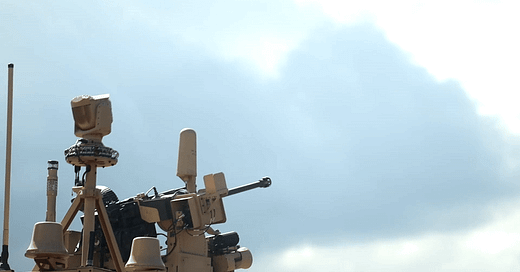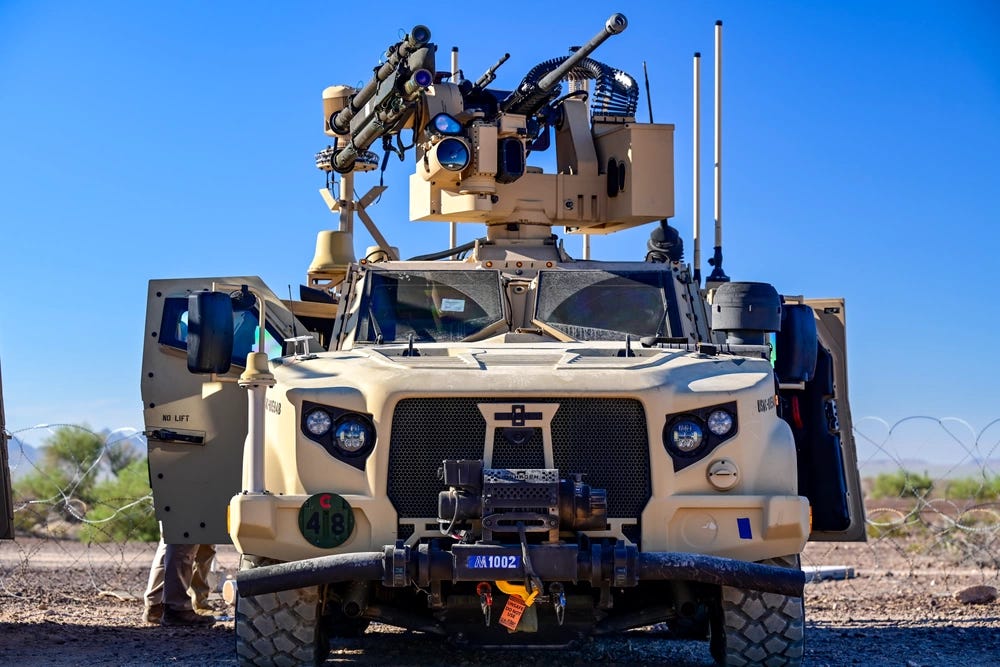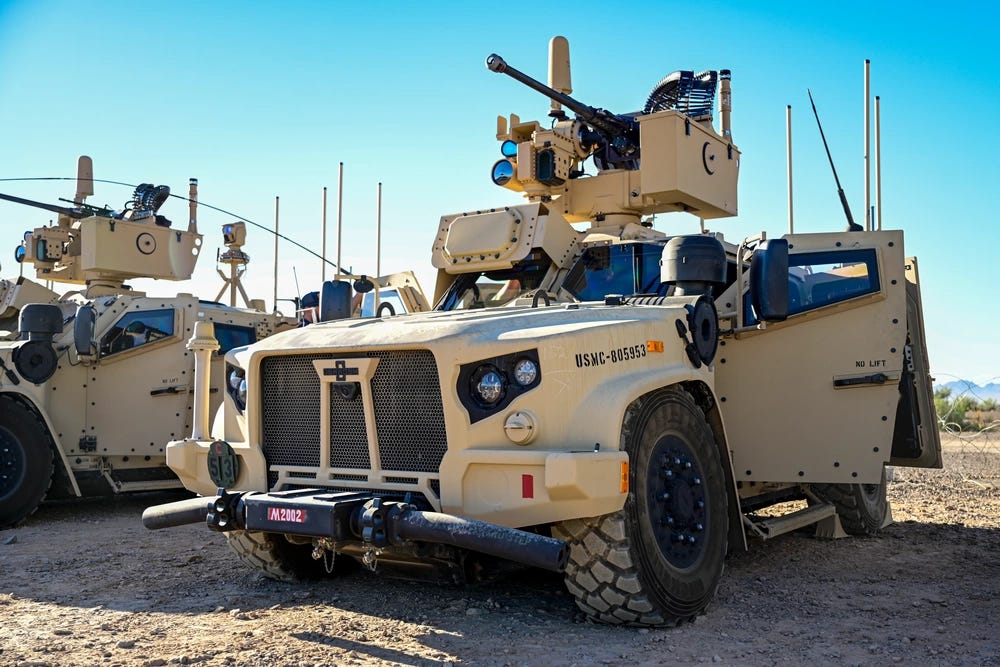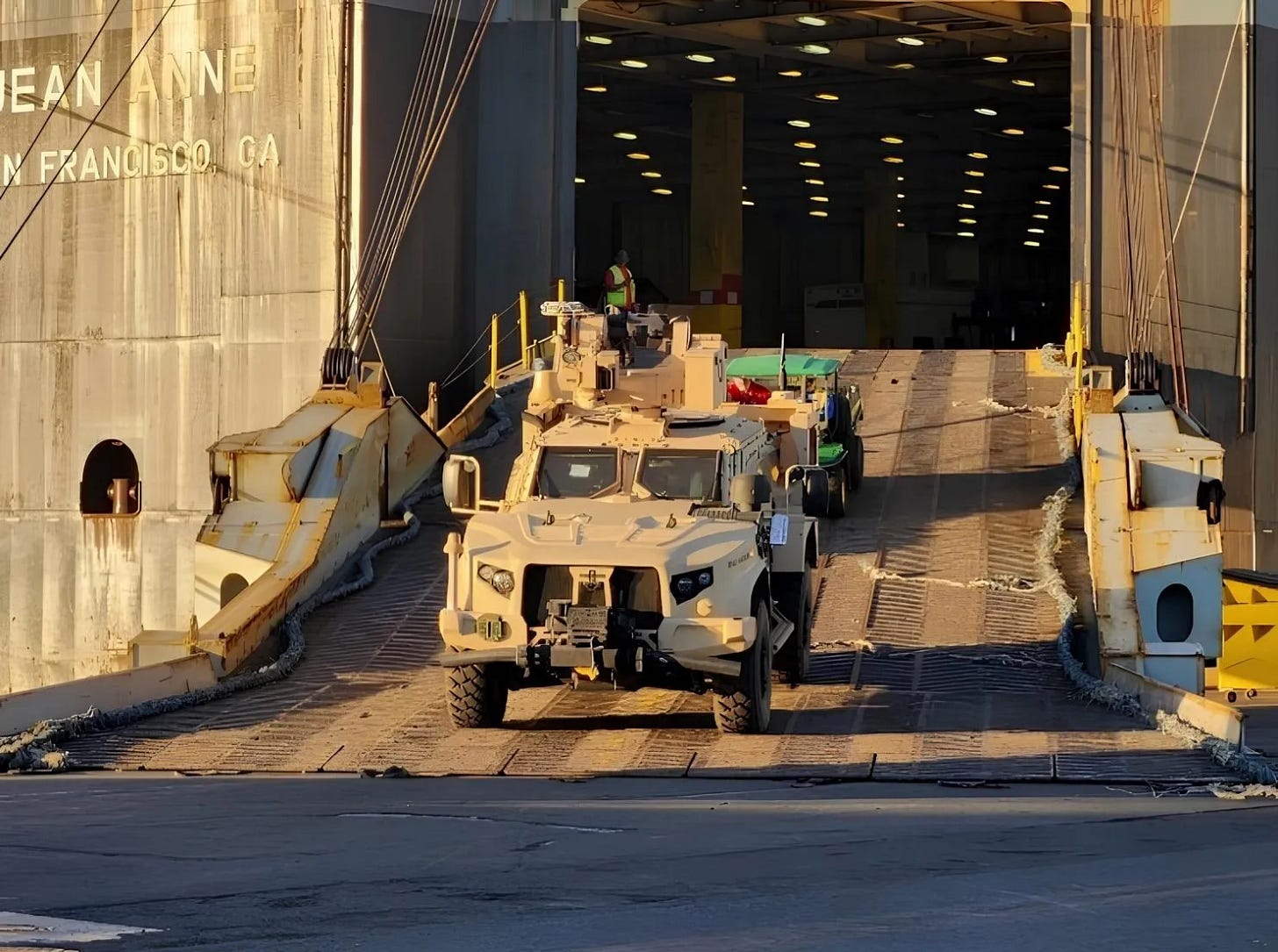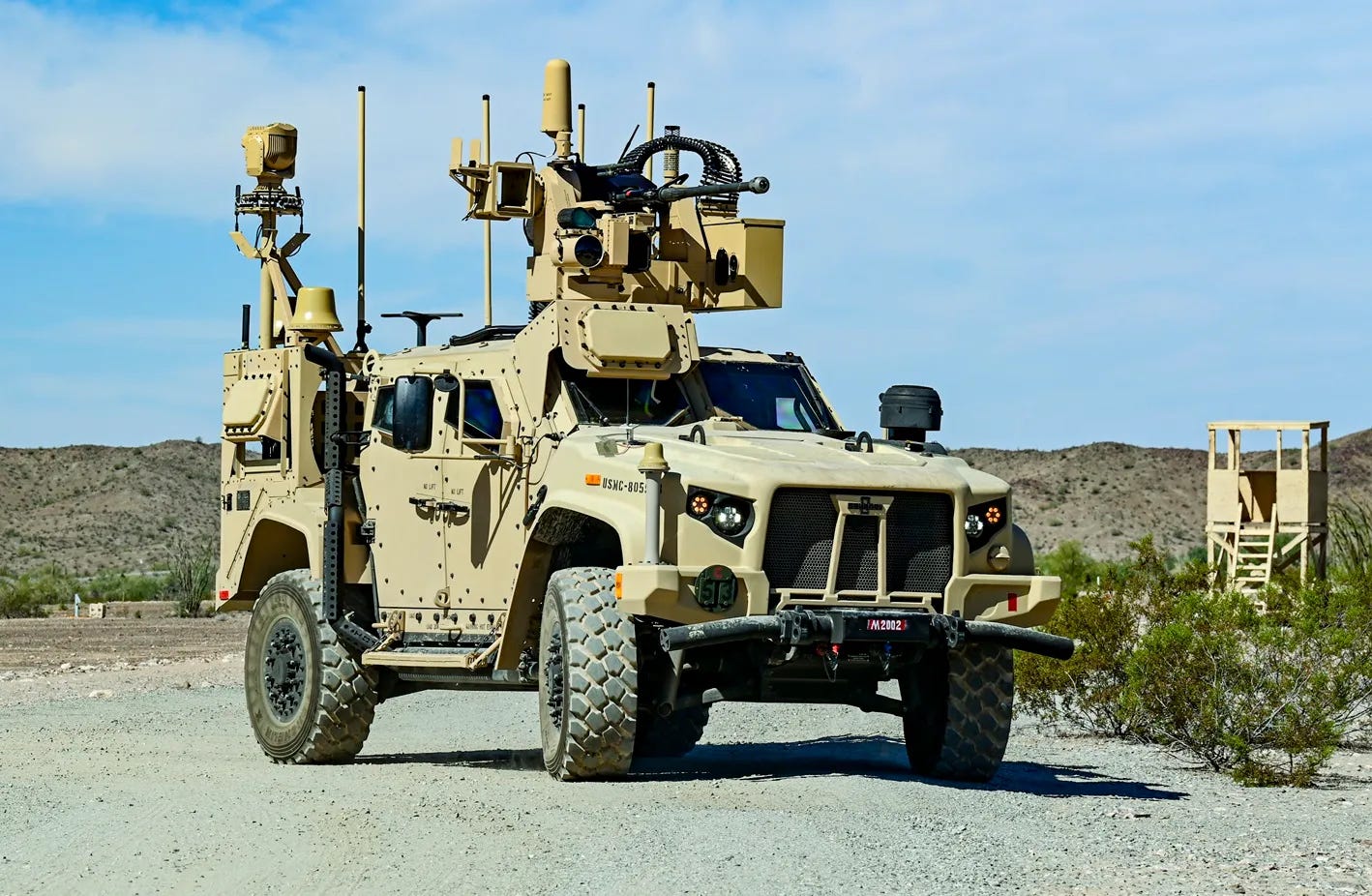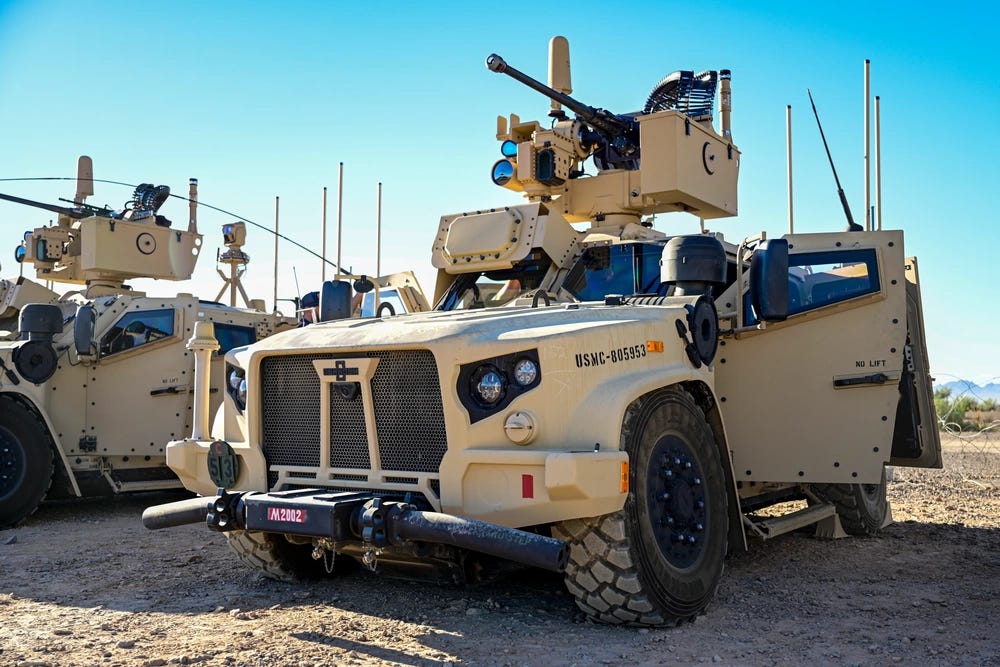MADIS: The Marine's Short Range Air Defense System for Expeditionary Warfare
The MADIS is a picture-perfect example of how the Marines will perform their roles in a future ware in the littorals.
The Engineer's Perspective is a reader-supported publication. Sign and up and subscribe to see more in-depth Aerospace/Aeronautical Analysis!
Table of Contents:
Introduction and Overview
Historical Development
Implications
Specifications
Concept of Operations
Systems Engineering
Systems Engineering Requirements
Calculations (Optional)
Conclusion
References
Introduction
The Marine Air Defense Integrated System (MADIS) is a pivotal asset in the U.S. Marine Corps' expeditionary warfare strategy, addressing the critical need for rapid deployment and mobility in establishing short-range air defense. Mounted on Joint Light Tactical Vehicle (JLTV), MADIS offers off-road capabilities, enabling Marine units to swiftly maneuver across diverse terrains. This mobility ensures that air defense systems can be rapidly positioned to protect forward-deployed forces from aerial threats, aligning seamlessly with the expeditionary requirement for quick operational readiness.
MADIS's design emphasizes not only rapid deployment but also swift exfiltration, allowing Marine units to relocate as mission parameters evolve. Its integration of advanced short-range radar systems, electronic warfare capabilities, and a combination of kinetic and non-kinetic interceptors provides a comprehensive defense against unmanned aerial systems (UAS) and low-flying aircraft. This versatility is crucial in dynamic combat environments where threats can emerge unexpectedly, and the ability to quickly establish or withdraw air defense perimeters can dictate mission success.
The system's operational effectiveness has been demonstrated in various exercises, notably with the 3rd Littoral Anti-Air Battalion (3d LAAB) in Hawaii. In December 2024, 3d LAAB conducted its inaugural live-fire exercise with MADIS, successfully engaging multiple drone targets. This achievement underscores MADIS's capability to provide immediate and reliable air defense in expeditionary settings, enhancing the Marine Corps' ability to protect its forces during rapid deployment and maneuver operations.
Overview:
The Marine Air Defense Integrated System (MADIS) consists of two complementary Joint Light Tactical Vehicles (JLTVs) working in tandem:
MADIS Mk1:
Primarily responsible for neutralizing fixed and rotary-wing aircraft, it’s equipped with:
Turret-launched Stinger missiles
Multi-functional electronic warfare capability
Direct fire weapon (likely an M240 machine gun or similar)
Electro-Optical/Infrared (EO/IR) optic
Shoulder-fired Stinger missiles for dismounted operations
30mm automatic cannon capable of firing proximity-fuzed rounds
MADIS Mk2:
Focusing on Counter-Unmanned Aircraft System (C-UAS) missions, MADIS Mk2 also provides radar and command and control (C2) for both vehicles. It’s equipped with:
M134 Minigun (7.62mm NATO rotary machine gun, 2,000-6,000 rounds/min)
Sensors:
RPS-42 AESA radar (360-degree coverage, detects targets at altitudes of 30–30,000 ft within a 30 km radius).
Electro-Optical Infrared (EO/IR) optic for target identification.
Electronic Warfare: Modi II system for jamming and disrupting UAV communications and navigation.
C2 Capability: Beyond Line of Sight (BLOS) server/gateway for networked targeting.
The two vehicles operate together, combining their capabilities to provide a unitfied air defense solution. The Mk1 focuses on larger aerial threats, while the Mk2 specializes in detecting and countering smaller unmanned systems and integrating radar and C2 functions for the system pair.
This complementary pairing enables the MADIS system to detect, track, identify, and engage a wide range of aerial threats, from traditional aircraft to modern unmanned systems, providing a versatile and mobile air defense capability for Marine Corps units.
Historical Development:
The development of the Marine Air Defense Integrated System (MADIS) reflects the U.S. Marine Corps' proactive approach to addressing evolving aerial threats through a series of strategic initiatives and technological advancements.
2013: Recognizing Emerging Threats
In 2013, the Marine Corps identified a critical gap in its ability to counter low-altitude aerial threats, particularly the increasing use of unmanned aerial systems (UAS) by adversaries. This realization underscored the necessity for a modernized, mobile air defense system capable of protecting maneuvering forces without relying solely on dismounted Stinger missiles and radar equipment transported by M1114 HMMWVs.
2016: Launch of the GBAD Future Weapons System Program
To address these capability gaps, the Marine Corps initiated the Ground-Based Air Defense (GBAD) Future Weapons System program in 2016. This program aimed to develop an integrated air defense solution that combined kinetic and electronic warfare capabilities, laying the foundation for what would eventually evolve into MADIS.
2018: Deployment of Light MADIS (LMADIS)
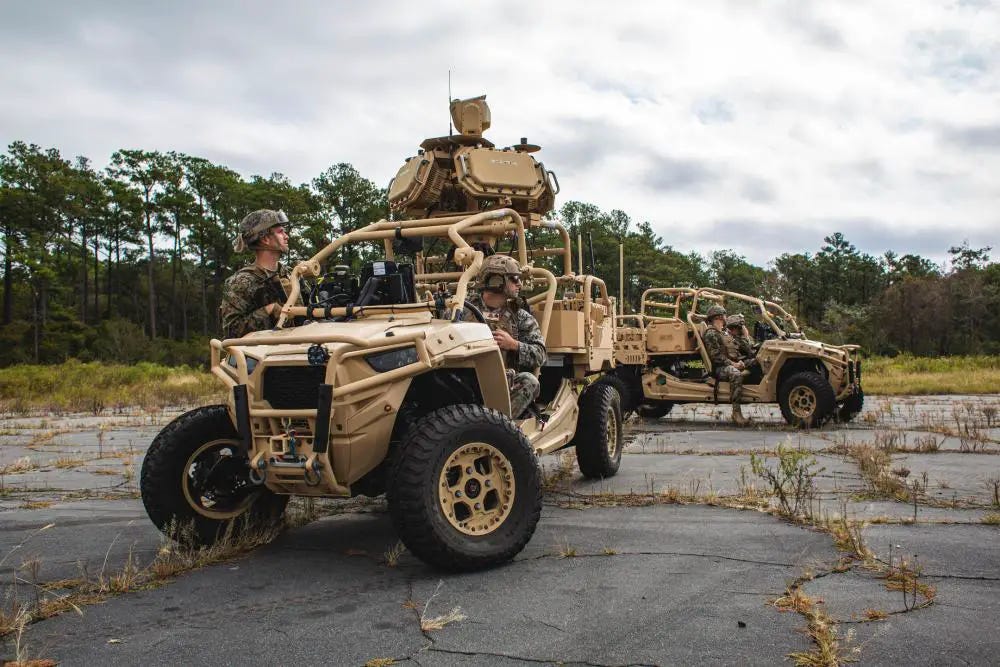
As an interim measure, the Marine Corps deployed the Light Marine Air Defense Integrated System (LMADIS) in 2018. Mounted on Polaris MRZR all-terrain vehicles, LMADIS provided a mobile platform equipped with radar and electronic warfare systems designed to detect and counter UAS threats. This deployment offered valuable operational insights and served as a testbed for system integration, informing the development of more robust air defense solutions.
2019: Operational Success in the Strait of Hormuz
The operational efficacy of LMADIS was notably demonstrated in July 2019 when it was deployed aboard the USS Boxer. In a real-world engagement, LMADIS successfully neutralized an Iranian drone in the Strait of Hormuz, showcasing its capability to protect naval vessels from UAS threats and highlighting the importance of integrated air defense systems in maritime operations.
2023: Advancements Toward Full Operational Capability
By 2023, the Marine Corps had made significant strides in advancing MADIS toward full operational capability. Successful live-fire testing of the low-rate initial production model was conducted at Yuma Proving Ground in Arizona. These tests validated the system's performance, including its ability to detect, track, and engage various aerial threats, marking a pivotal step in transitioning MADIS from development to active deployment.
2024: Fielding to Operational Units
In December 2024, the Marine Corps achieved a significant milestone by fielding MADIS to the 3rd Littoral Anti-Air Battalion (3d LAAB) in Hawaii. This deployment enhanced the unit's organic air defense capabilities, enabling them to effectively counter UAS and other low-altitude threats in diverse operational environments. The fielding of MADIS to active units represents the culmination of years of development and testing, providing the Marine Corps with a modern, mobile, and integrated air defense system.
The evolution of MADIS reflect's the Marine Corps' commitment to adapting to emerging threats through innovation and integration of advanced technologies, ensuring that Marine units are equipped with the necessary tools to maintain air superiority and protect ground forces in contemporary combat scenarios.
Implications:
MADIS provides Marine units with organic air defense capabilities, reducing reliance on external support and enabling autonomous operations in contested environments. This is essential during amphibious assaults and island fortifications where external air defense assets may not be available. The system integrates radar, surface-to-air missiles, and electronic warfare elements to protect against aerial threats, including unmanned aerial systems (UAS). With the increasing use of drones on the battlefield, MADIS provides detection, jamming, and neutralization capabilities to counter hostile UAS effectively.
Mounted on Joint Light Tactical Vehicles (JLTVs), MADIS combines mobility and firepower, allowing for rapid deployment and repositioning in response to threats. This mobility is particularly useful in island-hopping campaigns, where forces must quickly secure and defend multiple islands. Its modular design supports various missions, including convoy protection and forward base defense, ensuring continuous air defense coverage.
In modern island-hopping operations, MADIS helps establish air defense perimeters upon landing, securing beachheads and maintaining protection as forces advance. It is designed to operate in diverse environments, including dense jungles and rugged terrain, making it a key asset for sustained operations in regions like the South Pacific.
Applications in Island Hopping and Pacific Operations
As tensions rise in the Indo-Pacific, particularly in regions such as the South China Sea and the first island chain, MADIS is set for a significant role in supporting Marine Corps operations under the Force Design 2030 framework.
1. Securing Advanced Expeditionary Bases (EABs)
One of the Marine Corps' key strategies in the Pacific is Expeditionary Advanced Base Operations (EABO), where small, agile units establish forward operating locations on key islands. These bases enable long-range fires, surveillance, and logistical resupply in contested areas. However, they also present high-value targets for enemy air and missile attacks. MADIS provides a mobile, self-contained air defense system that allows Marines to establish defensive perimeters around these bases, protecting them from UAS reconnaissance, cruise missile strikes, and rotary-wing threats.
2. Supporting Distributed Maritime Operations (DMO)
MADIS enhances the naval-integrated combat posture by providing on-the-move air defense for Marine littoral regiments and expeditionary units. As the Marine Corps adopts a distributed force structure to counter China’s Anti-Access/Area Denial (A2/AD) strategies, MADIS ensures that dispersed units remain protected from enemy air threats, even when operating independently or across multiple islands.
3. Enhancing Littoral Maneuver and Island-Hopping Campaigns
During an island-hopping campaign, Marines must establish temporary footholds on multiple islands to project power, interdict enemy forces, and establish logistics chains. Traditional air defense solutions—such as Navy destroyers or land-based missile batteries—may not be available in every engagement. MADIS provides an organic, mobile solution that can be rapidly deployed to newly secured islands, ensuring that Marine forces maintain localized air superiority while advancing through the battlespace.
4. Countering Chinese and Regional Adversary Drone Warfare
China has significantly expanded its use of drones for surveillance, targeting, and strike capabilities in the Pacific theater. MADIS acts as a critical countermeasure to these threats, denying the PLA the ability to use drones for battlefield awareness or precision strikes against Marine units. By integrating electronic attack capabilities and kinetic interceptors, MADIS allows the Marine Corps to neutralize PLA reconnaissance and attack drones, giving U.S. forces a significant advantage in controlling information and preventing enemy forces from gaining targeting data.
5. Rapid Response to Emerging Threats
In a rapidly escalating conflict scenario, MADIS can be airlifted or transported via amphibious ships to critical areas, providing immediate air defense coverage. Whether responding to hostile incursions, gray-zone activities, or sudden UAS swarms, MADIS ensures that Marine forces can quickly establish defensive postures and continue operations without excessive reliance on external assets.
The deployment of MADIS represents a game-changing capability for the U.S. Marine Corps, particularly as it pivots toward expeditionary, distributed, and maritime-based combat in the Pacific. By enhancing force protection, countering aerial threats, and providing mobile air defense, MADIS enables Marine forces to execute island-hopping campaigns, defend forward bases, and maintain deterrence in contested environments. As adversaries increasingly rely on drones and precision-strike capabilities, MADIS ensures that the Marine Corps remains resilient, agile, and lethal in the evolving battlespace.
Specifications:
The Marine Air Defense Integrated System (MADIS) is a modular and scalable air defense solution developed by the U.S. Marine Corps to address evolving aerial threats. Mounted on the Joint Light Tactical Vehicle (JLTV) platform, MADIS offers high mobility and adaptability across diverse operational terrains. The system comprises two primary variants, MADIS Mk1 and MADIS Mk2, which operate in tandem to provide comprehensive air defense coverage.
MADIS Mk1:
Armament:
Turret-Mounted Weapons: Equipped with a Kongsberg Defense Protector RS6 remote weapon station, the Mk1 variant features an XM914E1 30mm chain gun and an M240 7.62mm machine gun, enabling effective engagement of various aerial threats.
Missile Systems: Incorporates turret-launched Stinger missiles for mounted operations and includes provisions for shoulder-fired Stinger missiles, allowing dismounted Marines to engage low-altitude aircraft and unmanned aerial systems (UAS).
Sensors and Targeting:
Electro-Optical/Infrared (EO/IR) Optics: Provides advanced target acquisition and tracking capabilities, enhancing engagement accuracy in various environmental conditions.
Electronic Warfare (EW):
Multi-Functional EW Capabilities: Enables detection and disruption of hostile UAS and communication systems, augmenting the system's defensive measures against a spectrum of aerial threats.
MADIS Mk2:
Radar and Detection:
360-Degree Radar System: The MADIS mk2 Utilizes a comprehensive radar setup capable of detecting low-altitude aerial threats. Consisting of RADA’s Advanced Compact Hemispheric Radars (aCHR) mounted on 4 sides of the vehicle, the MADIS Mk2 radar is adept at detecting low-altitude aerial threats, such as drones with minimal radar cross-sections within a 30km radius for early warning and situational awareness.
Detection Range and Coverage: The RPS-42 offers a detection range of up to 30 kilometers, effectively identifying targets at altitudes ranging from 30 to 30,000 feet. Its 360-degree coverage ensures that no aerial threat goes unnoticed within its operational vicinity.
Integration with Command and Control (C2): The radar seamlessly integrates with the MADIS Mk2's advanced C2 suite, facilitating real-time data processing and dissemination. This integration enables coordinated responses and engagement decisions, enhancing the system's overall efficacy.
Operational Benefits: The comprehensive coverage and precision of the RPS-42 radar significantly bolster the MADIS Mk2's ability to detect, track, and engage a variety of aerial threats. This capability is crucial for protecting Marine Corps assets and personnel in diverse and dynamic operational environments.
The integration of MADIS Mk1 and Mk2 variants provides a layered and adaptable defense system capable of detecting, tracking, and neutralizing a wide array of aerial threats. The JLTV-mounted platform ensures that MADIS units can rapidly deploy and reposition in response to dynamic threat environments, maintaining continuous protection for Marine Corps assets and personnel. This modular architecture not only addresses current operational requirements but also allows for future upgrades and integration of emerging technologies, ensuring sustained operational superiority in the face of evolving threats.
Concept of Operations
The Marine Air Defense Integrated System (MADIS) is a critical component of the Marine Corps' layered air defense strategy, ensuring close-in protection for maneuvering forces and high-value assets. This Concept of Operations (CONOPS) outlines the operational framework, roles, and procedures for deploying and utilizing MADIS to enhance battlefield air defense capabilities.
Stakeholders:
Marine Corps air defense units
Ground combat commanders
Tactical aviation and air defense coordination teams
Electronic warfare specialists
Logistics and sustainment personnel
Purpose:
The primary purpose of MADIS is to provide a mobile, adaptable, and networked air defense capability against a wide range of aerial threats, including unmanned aerial systems (UAS), rotary-wing, and fixed-wing aircraft. By integrating kinetic and non-kinetic countermeasures, MADIS ensures continuous protection for Marine Corps units in dynamic operational environments.
Operational Overview:
Deployment Configuration:
MADIS units are structured into sections consisting of paired MADIS Mk1 and MADIS Mk2 vehicles.
This configuration allows for coordinated detection, tracking, and engagement of aerial threats using complementary sensor and weapon systems.
Pre-Deployment Operations:
Mission Planning: Operational planning is conducted in coordination with higher-echelon command, considering the tactical threat environment and mission objectives.
Equipment Readiness: All system components, including weapons, sensors, and electronic warfare (EW) capabilities, are tested and calibrated before deployment.
Integration with Air Defense Networks: MADIS is linked with Marine Corps and joint-force air defense networks to ensure real-time situational awareness and coordinated threat responses.
Operational Roles:
MADIS Mk1:
Primarily responsible for kinetic engagements.
Equipped with a 30mm cannon and Stinger missiles for direct threat neutralization.
MADIS Mk2:
Focused on surveillance, target acquisition, and electronic warfare.
Utilizes radar and EW systems to detect, track, and disrupt or disable hostile UAS and other aerial threats.
Mission Execution:
Detection and Identification: MADIS Mk2 scans the battlespace for aerial threats, sharing real-time data with MADIS Mk1 and other networked units.
Threat Engagement: Based on the threat assessment, MADIS Mk1 executes kinetic engagements using its 30mm cannon or Stinger missiles, while MADIS Mk2 employs EW capabilities to disrupt enemy operations.
Dynamic Repositioning: MADIS units are highly mobile, capable of adjusting positions in response to evolving threats and changes in the tactical environment.
Post-Engagement and Sustainment:
Battle Damage Assessment (BDA): Following engagements, BDA is conducted to evaluate mission effectiveness and refine future tactics.
Maintenance and Resupply: Units conduct routine maintenance on weaponry, sensors, and communication systems to sustain operational readiness.
Lessons Learned and Tactical Adjustments: Data and feedback from operations are analyzed to enhance MADIS tactics and integration with other air defense assets.
Key Capabilities:
Integrated Kinetic and Non-Kinetic Countermeasures: Seamless coordination between weapon systems and EW capabilities for a layered defense approach.
Real-Time Networked Operations: MADIS interfaces with Marine Corps and joint air defense networks to enable synchronized threat responses.
High Mobility and Flexibility: JLTV-mounted platforms allow rapid repositioning across varied terrains, ensuring adaptive protection for maneuvering forces.
Enhanced Survivability: Designed to operate in contested environments, MADIS enhances force survivability by countering air threats before they can impact ground operations.
Summary:
MADIS provides a highly mobile, networked, and multi-layered air defense solution, combining surveillance, electronic warfare, and direct fire capabilities to protect Marine Corps units. By integrating with existing air defense networks and leveraging advanced detection and engagement technologies, MADIS ensures continuous air defense coverage in complex and evolving battlespaces.
Systems Engineering
This systems engineering overview outlines the development and deployment of the Marine Air Defense Integrated System (MADIS). It addresses key engineering aspects, including objectives, integration, operational challenges, and validation processes, to ensure MADIS meets operational requirements and adapts to evolving threats.
System Objectives
Primary Functions:
Provide short-range air defense against unmanned aerial systems (UAS), fixed-wing, and rotary-wing threats.
Key Operational Capabilities:
Seamless integration of kinetic and electronic warfare tools for versatile threat engagement.
Mission Requirements:
Operate effectively in dynamic combat scenarios to protect Marine Corps assets and maneuvering forces.
Support real-time data sharing and coordination with broader air defense networks.
Performance Goals:
High probability of detection and identification of aerial threats.
Rapid and accurate engagement capabilities.
Resilience against electronic warfare and cyber threats.
Operating Conditions
Environmental Parameters:
Capable of functioning in diverse terrains, including urban, desert, maritime, and jungle environments.
Designed to withstand extreme weather conditions, including high temperatures, humidity, and sand/dust exposure.
Operational Constraints:
Must maintain continuous operational readiness with minimal logistical support.
Operate within joint and coalition force structures to enable interoperability.
Infrastructure Requirements:
Requires integration with Marine Corps command-and-control systems and joint air defense networks.
Dependence on secure, real-time communication links for coordinated threat response.
Maintenance Conditions:
Modular and field-serviceable components to enable rapid maintenance and sustainment.
Regular system updates to enhance electronic warfare and cybersecurity resilience.
Expected Opposition/Challenges
Potential Threats:
Adversarial use of low-cost, swarm-capable UAS.
Advanced electronic warfare techniques aimed at disrupting MADIS operations.
High-speed, low-observable aerial threats that challenge detection and engagement timelines.
Countermeasures & Advantages:
Multi-layered sensor fusion, combining radar, EO/IR, and electronic warfare for enhanced threat tracking.
Networked operations ensuring interoperability with Marine Corps and joint forces.
Advanced cybersecurity protocols to mitigate electronic warfare vulnerabilities.
Design Considerations
Modularity for Upgrades:
Open architecture design to support future weapon, sensor, and software enhancements.
Scalability for Future Growth:
Adaptable system capable of evolving with emerging threats and technological advancements.
Interoperability with Existing Systems:
Seamless integration with existing Marine Corps and joint force air defense networks.
Cost-Effectiveness in Production and Operation:
Balance between capability enhancements and affordability to ensure long-term sustainability.
Verification and Validation
Testing Procedures:
Live-fire and simulated engagement tests to validate performance in combat conditions.
Simulation Requirements:
Continuous development of digital twin simulations to assess system effectiveness against evolving threats.
Acceptance Criteria:
Must meet all operational performance benchmarks, including detection accuracy, engagement speed, and electronic warfare resilience.
Certification Needs:
Compliance with DoD cybersecurity and electronic warfare standards.
Successful integration trials with Marine Corps air defense command-and-control systems.
Systems Engineering Requirements:
Based on the Concept of Operations, the following Systems Engineering Requirements are derived. These requirements ensure that the Marine Air Defense Integrated System (MADIS) meets operational, environmental, and technical expectations while maintaining reliability and effectiveness in combat scenarios.
Functional Requirements
The system shall detect, track, and identify aerial threats, including unmanned aerial systems (UAS), rotary-wing, and fixed-wing aircraft, using radar, electro-optical, and infrared sensors.
The system shall neutralize aerial threats using kinetic (missiles, autocannons) and non-kinetic (electronic warfare, directed energy) countermeasures to provide a layered defense approach.
The system shall integrate with existing Marine Corps and Joint Force air defense networks, ensuring seamless communication and data sharing for coordinated threat response.
The system shall operate autonomously with AI-driven target classification or under remote control by a human operator for flexible engagement options.
Physical Requirements
The system shall fit within the constraints of the Joint Light Tactical Vehicle (JLTV) platform while maintaining operational mobility and deployability.
The system shall utilize a modular design, enabling component upgrades, system scalability, and field maintenance with minimal logistical burden.
The system shall meet weight distribution requirements to maintain vehicle stability, preventing adverse impacts on mobility and operational performance.
The system shall incorporate ruggedized components to withstand the rigors of battlefield deployment, including vibrations, impacts, and rough terrain.
Environmental Requirements
The system shall function in extreme weather conditions, including temperatures ranging from -40 to 55 degrees Celsius, ensuring operational capability in arctic, desert, and tropical environments.
The system shall be resistant to water, dust, and shock in accordance with MIL-STD-810G standards, ensuring durability in adverse environmental conditions.
The system shall maintain operational effectiveness in electromagnetic warfare environments by incorporating shielding and anti-jamming capabilities against adversary electronic countermeasures.
The system shall remain operational in low-visibility conditions such as fog, heavy rain, and sandstorms, utilizing multi-spectral sensor fusion for effective threat detection and tracking.
Maintenance Requirements
The system shall allow field-level maintenance using standard Marine Corps tools, enabling rapid repairs and minimizing logistical overhead.
The system shall provide a predictive maintenance capability based on system diagnostics, alerting operators to potential failures before they impact mission readiness.
The system shall support modular component replacements to minimize downtime, allowing operators to swap out malfunctioning subsystems without requiring extensive depot-level maintenance.
The system shall include built-in-test (BIT) functionalities for self-diagnosis, reducing the time needed to identify and troubleshoot faults.
Interface Requirements
The system shall integrate with the Marine Corps’ Command and Control (C2) systems, providing real-time data exchange for improved situational awareness and threat assessment.
The system shall support data exchange with external sensor networks, including ground-based and airborne radar systems, for enhanced detection and tracking accuracy.
The system shall provide a user-friendly interface for operators with minimal training, ensuring ease of use and rapid decision-making in high-stress combat environments.
The system shall incorporate secure communication links to prevent data interception and cyber threats from adversary forces.
Safety and Reliability Requirements
The system shall include redundant power and control systems to ensure mission continuity in the event of component failures or combat damage.
The system shall implement safety protocols to prevent accidental engagements, including target verification measures and human-in-the-loop confirmation for lethal countermeasures.
The system shall achieve an operational readiness rate of 95% over a defined mission period, ensuring high availability for air defense operations.
The system shall feature fail-safe mechanisms to disable or neutralize it in case of unauthorized access or capture by adversaries.
Verification and Validation
The system shall undergo rigorous testing, including live-fire exercises, simulated engagements, and electromagnetic interference assessments to validate its performance.
The system shall meet acceptance criteria defined by the U.S. Marine Corps before deployment, ensuring compliance with operational and safety standards.
The system shall demonstrate compliance with all cybersecurity and electronic warfare resilience standards, ensuring protection against hacking, jamming, and spoofing threats.
The system shall undergo real-world field trials in diverse operational environments to verify effectiveness against current and emerging threats.
Conclusion:
The Marine Air Defense Integrated System (MADIS) represents an important pivotal advancement in the U.S. Marine Corps’ air defense capabilities moving forward due to the great power competition that is expected between the United States and China.
Designed to address emerging aerial threats such as drones and low-flying aircraft, MADIS integrates detection, tracking, and engagement systems within a mobile, battlefield-ready platform. By leveraging the Joint Light Tactical Vehicle (JLTV) and incorporating modular components, MADIS enhances operational agility, adaptability, and effectiveness. Recent live-fire tests have validated its ability to counter evolving threats, demonstrating its capability in real-world scenarios.
With the rapid proliferation of unmanned aerial threats, MADIS provides the Marine Corps with a crucial defensive tool, ensuring battlefield superiority and force protection.
As adversaries continue to develop advanced drone and air attack capabilities, the Marine Corps must continuously refine and upgrade MADIS. Future improvements may include enhanced AI-driven targeting, longer-range engagement systems, and deeper integration with joint force networks. Investing in these upgrades will ensure MADIS remains a cornerstone of Marine Corps air defense for years to come.
References:
U.S. Marine Corps Systems Command. (2023). Marine Air Defense Integrated System Overview.
Defense News. (2023). Marine Corps Conducts Successful MADIS Live-Fire Exercise at Yuma Proving Ground.
The War Zone. (2019). Marine Corps Light MADIS Downs Iranian Drone Over Strait of Hormuz.
Congressional Research Service. (2022). Short-Range Air Defense (SHORAD) Developments in the U.S. Military.
U.S. Department of Defense. (2023). Annual Report on Counter-UAS Strategies and Technologies.
https://euro-sd.com/2024/04/articles/37396/counter-uav-meeting-emerging-threats/
https://missiledefenseadvocacy.org/defense-systems/marine-air-defense-integrated-system-madis/
https://thedefensepost.com/2024/01/15/us-madis-air-defense-test/
https://www.kongsberg.com/kda/what-we-do/defence-and-security/remote-weapon-systems/protector-rs6/
The Engineer's Perspective is a reader-supported publication. To receive new posts and support my work, consider becoming a free or paid subscriber.

